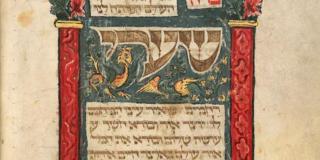
Esther Scroll
Binyamin Zeʼev ben Zalman (scribe), unknown artist
Esther Scroll
Illuminated manuscript on vellum
[Alsace], 1799
In the Jewish tradition, the biblical book of Esther is often presented in the form of a scroll. Esther, a Jewish woman living in Persia in the 5th century BCE, saved her people after Haman, an official in the court of the Persian King Achashverosh, had plotted to kill all the Jews in the empire. The story is traditionally read in synagogues during the festival of Purim. This scroll was most likely made in Alsace, France, and the protagonists carry swords and wear wigs and court dress that are typical of Europe in the 18th century. On the right, Esther kneels before King Achashverosh, inviting him to a banquet with her and Haman. On the left, Haman visits Achashverosh in his bedroom at night to ask for permission to hang Esther’s cousin Mordecai, and then prepares a tree for Mordecai’s execution.
The New York Public Library believes that this item is in the public domain under the laws of the United States, but did not make a determination as to its copyright status under the copyright laws of other countries. This item may not be in the public domain under the laws of other countries.






